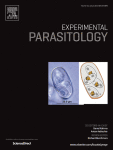Ver ítem
- xmlui.general.dspace_homeCentros Regionales y EEAsCentro Regional Santa FeEEA RafaelaArtículos científicosxmlui.ArtifactBrowser.ItemViewer.trail
- Inicio
- Centros Regionales y EEAs
- Centro Regional Santa Fe
- EEA Rafaela
- Artículos científicos
- Ver ítem
Typification of virulent and low virulence Babesia bigemina clones by 18S rRNA and rap-1c
Resumen
The population structure of original Babesia bigemina isolates and reference strains with a defined phenotypic profile was assessed using 18S rRNA and rap-1c genes. Two reference strains, BbiS2P-c (virulent) and BbiS1A-c (low virulence), were biologically cloned in vitro. The virulence profile of the strains and clones was assessed in vivo. One fully virulent and one low-virulence clone were mixed in identical proportions to evaluate their growth
[ver mas...]
The population structure of original Babesia bigemina isolates and reference strains with a defined phenotypic profile was assessed using 18S rRNA and rap-1c genes. Two reference strains, BbiS2P-c (virulent) and BbiS1A-c (low virulence), were biologically cloned in vitro. The virulence profile of the strains and clones was assessed in vivo. One fully virulent and one low-virulence clone were mixed in identical proportions to evaluate their growth efficiency in vitro. Each clone was differentiated by two microsatellites and the gene gp45. The 18S rRNA and rap-1c genes sequences from B. bigemina biological clones and their parental strains, multiplied exclusively in vivo or in vitro, were compared with strain JG-29. The virulence of clones derived from the BbiS2P-c strain was variable. Virulent clone Bbi9P1 grew more efficiently in vitro than did the low-virulence clone Bbi2A1. The haplotypes generated by the nucleotide polymorphism, localized in the V4 region of the 18S rRNA, allowed the identification of three genotypes. The rap-1c haplotypes allowed defining four genotypes. Parental and original strains were defined by multiple haplotypes identified in both genes. The rap-1c gene, analyzed by high-resolution melting (HRM), allowed discrimination between two genotypes according to their phenotype, and both were different from JG-29. B. bigemina biological clones made it possible to define the population structure of isolates and strains. The polymorphic regions of the 18S rRNA and rap-1c genes allowed the identification of different subpopulations within original B. bigemina isolates by the definition of several haplotypes and the differentiation of fully virulent from low virulence clones.
[Cerrar]

Fuente
Experimental Parasitology 141 : 98-105 (June 2014)
Fecha
2014-06
ISSN
0014-4894
Formato
pdf
Tipo de documento
artículo
Palabras Claves
Derechos de acceso
Restringido
 Excepto donde se diga explicitamente, este item se publica bajo la siguiente descripción: Creative Commons Attribution-NonCommercial-ShareAlike 2.5 Unported (CC BY-NC-SA 2.5)
Excepto donde se diga explicitamente, este item se publica bajo la siguiente descripción: Creative Commons Attribution-NonCommercial-ShareAlike 2.5 Unported (CC BY-NC-SA 2.5)

